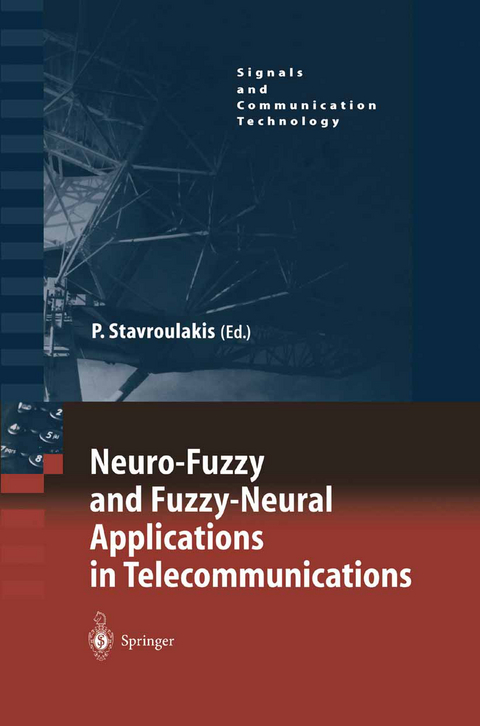
Neuro-Fuzzy and Fuzzy-Neural Applications in Telecommunications
Springer Berlin (Verlag)
978-3-540-40759-1 (ISBN)
1 Introduction.- 2 Integration of Neural and Fuzzy.- 2.1 Introduction.- 2.2 Hybrid Artificial Intelligent Systems.- References.- 3 Neuro-Fuzzy Applications in Speech Coding and Recognition.- 3.1 Introduction.- 3.2 Soft Computing.- 3.3 FuGeNeSys: A Neuro-Fuzzy Learning Tool for Fuzzy Modeling.- 3.4 Conventional Speech Coding and Recognition Techniques.- 3.5 A Soft Computing-Based Approach in Speech Classification.- 3.6 Neuro-Fuzzy Applications in Speech Coding and Recognition.- 3.7 Conclusions.- References.- 4 Image/Video Compression Using Neuro-Fuzzy Techniques.- 4.1 Introduction.- 4.2 Neuro-Fuzzy Techniques.- 4.3 Neuro-Fuzzy Based Vector Quantization for Image Compression.- 4.4 Image Transmission by NITF.- 4.5 Neuro-Fuzzy Based Video Compression.- References.- 5 A Neuro-Fuzzy System for Source Location and Tracking in Wireless Communications.- 5.1 Introduction.- 5.2 Problem Statement.- 5.3 The Architecture of the Fuzzy-Neural Network.- 5.4 Design of the Rule Base.- 5.5 Simulations.- 5.6 Neuro-Fuzzy System Evaluation.- References.- 6 Fuzzy-Neural Applications in Handoff.- 6.1 Introduction.- 6.2 Application of a Neuro-Fuzzy System to Handoffs in Cellular Communications.- References.- 6.3 Handoff Based Quality of Service Control in CDMA Systems Using Neuro-Fuzzy Techniques Bongkarn Homnan, Watit Benjapolakul.- References.- 7 An Application of Neuro-Fuzzy Systems for Access Control in Asynchronous Transfer Mode Networks.- 7.1 Introduction.- 7.2 Traffic Control in ATM Networks.- 7.3 Traffic Source Model and Traffic Policing Mechanism.- 7.4 Performance of FLLB Policing Mechanism.- 7.5 Performance of NFS LB Policing Mechanism.- 7.6 Evaluation of Simulation Results.- References.- Appendix A. Overview of Neural Networks.- A.1 Introduction.- A.2 Learning by Neural Networks.- A.3Examples of Neural Network Structures for PR Applications.- References.- Appendix B. Overview of Fuzzy Logic Systems.- B.1 Introduction.- B.2 Overview of Fuzzy Logic.- B.3 Examples.- References.- Appendix C. Examples of Fuzzy-Neural and Neuro-Fuzzy Integration.- C.1 Fuzzy-Neural Classification.- C.2 Fuzzy-Neural Clustering.- C.3 Fuzzy-Neural Models for Image Processing.- C.4 Fuzzy-Neural Networks for Speech Recognition.- C.5 Fuzzy-Neural Hybrid Systems for System Diagnosis.- C.6 Neuro-Fuzzy Adaptation of Learning Parameters - An Application in Chromatography.- References.
| Erscheint lt. Verlag | 24.3.2004 |
|---|---|
| Reihe/Serie | Signals and Communication Technology |
| Zusatzinfo | XVIII, 339 p. |
| Verlagsort | Berlin |
| Sprache | englisch |
| Maße | 155 x 235 mm |
| Gewicht | 650 g |
| Themenwelt | Technik ► Elektrotechnik / Energietechnik |
| Technik ► Nachrichtentechnik | |
| Schlagworte | Coding • Cognition • Communication • communications • Control • fuzzy • Fuzzy Logic • Fuzzy-Logik • Fuzzy-Logik / Unscharfe Logik • fuzzy system • Image Processing • learning • Modeling • Neural networks • Simulation • Speech Recognition • Spread spectrum techniques • telecommunications • Telekommunikationstechnik • Tracking |
| ISBN-10 | 3-540-40759-6 / 3540407596 |
| ISBN-13 | 978-3-540-40759-1 / 9783540407591 |
| Zustand | Neuware |
| Haben Sie eine Frage zum Produkt? |
aus dem Bereich


